Cinematographers on cameras and lenses from 9 titles in 2020
Hear direct from the cinematographers of Australian film, television, documentary and web series as they break down what they filmed with and why.
Whether it was observational documentaries in the Northern Territory, atmospheric horror features or naturalistic television drama, cinematographers employed a variety of cameras and lenses to craft the unique looks of Australian titles in 2020.
In the following article they explain what these choices were and why.
Unsure of some of the terms? A cheat sheet is at the bottom of the story.
All of the projects received Screen Australia funding.
(In alphabetical order)
Cinematographer: Andrew Commis ACS
Director: Shannon Murphy
Filmed on ARRI ALEXA Mini with Super Baltar lenses
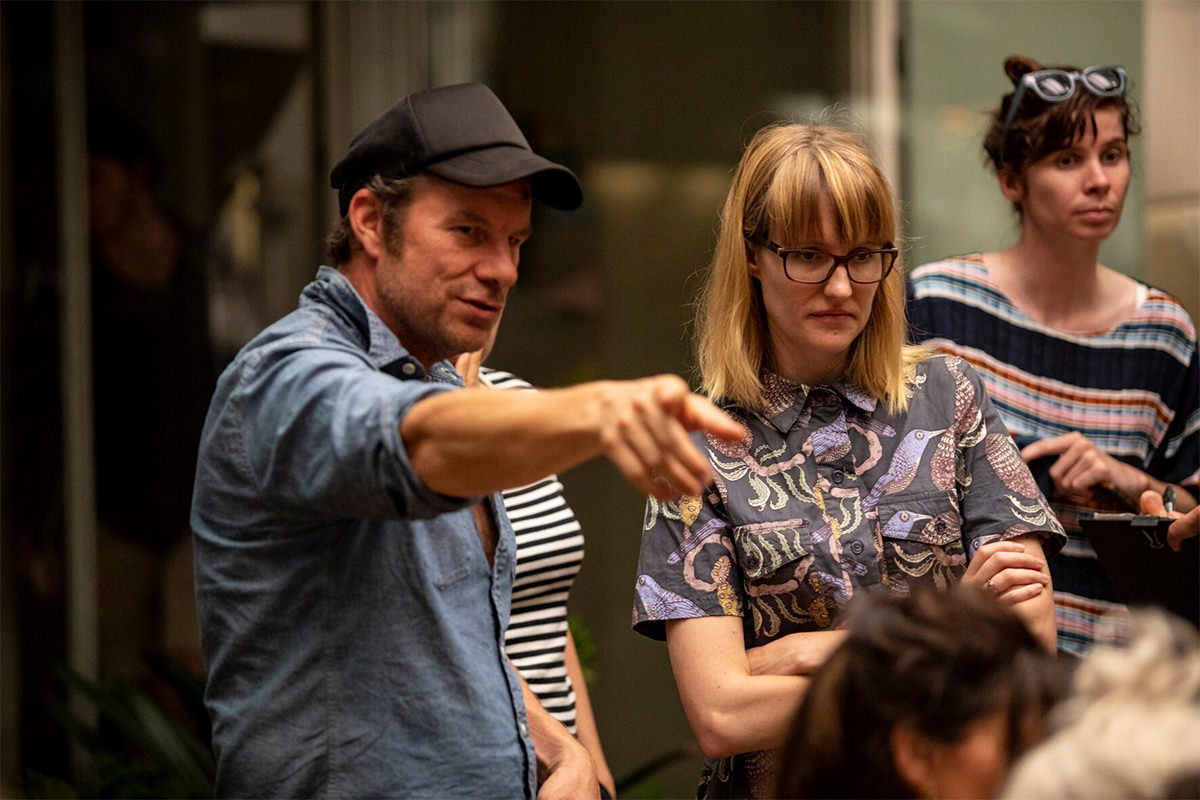 Andrew Commis ACS with Shannon Murphy on the set of Babyteeth
Andrew Commis ACS with Shannon Murphy on the set of Babyteeth
Written by Rita Kalnejais and based on her play of the same name, this feature swept the 2020 AACTA Awards, picking up nine gongs including Best Director for Shannon Murphy in her feature debut. The bittersweet comedy made its world premiere in competition at Venice International Film Festival in 2019 and follows seriously ill teenager Milla (Eliza Scanlen) who, much to the horror of her parents (Essie Davis and Ben Mendelsohn) falls madly in love with smalltime drug dealer Moses (Toby Wallace). As the one-liner says “Babyteeth is a heartbreaking comedy about how good it is not to be dead yet and how far we will go for love.” Listen to a podcast with Shannon Murphy here
Andrew Commis ACS: Shannon and I spoke very early on about how we wanted Babyteeth to feel immediate. We wanted a strong sense of perspective, largely Milla’s, and we needed a responsive energy. It instinctively felt like that meant the camera was on my shoulder so I could be the one responding rather than just following. We wanted the human presence in the film to be really strong. So the ALEXA Mini was pretty much a given, I just feel so comfortable with that sensor and what I can do with it. Then I did a bunch of lens tests like I normally do before a film as more of a creative search more than a technical exercise.
One of our visual keys was not to make it glossy or slick, we needed to have the imperfections of life. My initial instinct was something like Super Baltars. They’re a pretty unique lens set made by the optical company Bausch & Lomb in the 1950s. It was their one and only foray into photographic lens production. I don’t use them often but I really love their character. There’s a softness to them which makes them very flattering and they have such a warmth. I felt that was really important to have. We spoke early about how the film should never look grim or gloomy. We didn’t want to telegraph what might happen to Milla. The film should never wallow in that sentiment. So that’s what we confirmed in the tests and I went with the Super Baltars. I’m especially thankful to Panavision who brought in a lovely set for us.
Rent or buy Babyteeth on Apple TV, Amazon, Fetch or YouTube now.
Cinematographer: Dylan River
Director: Warwick Thornton
Filmed on Panavision DXL2 with Panavision Primo70 lenses
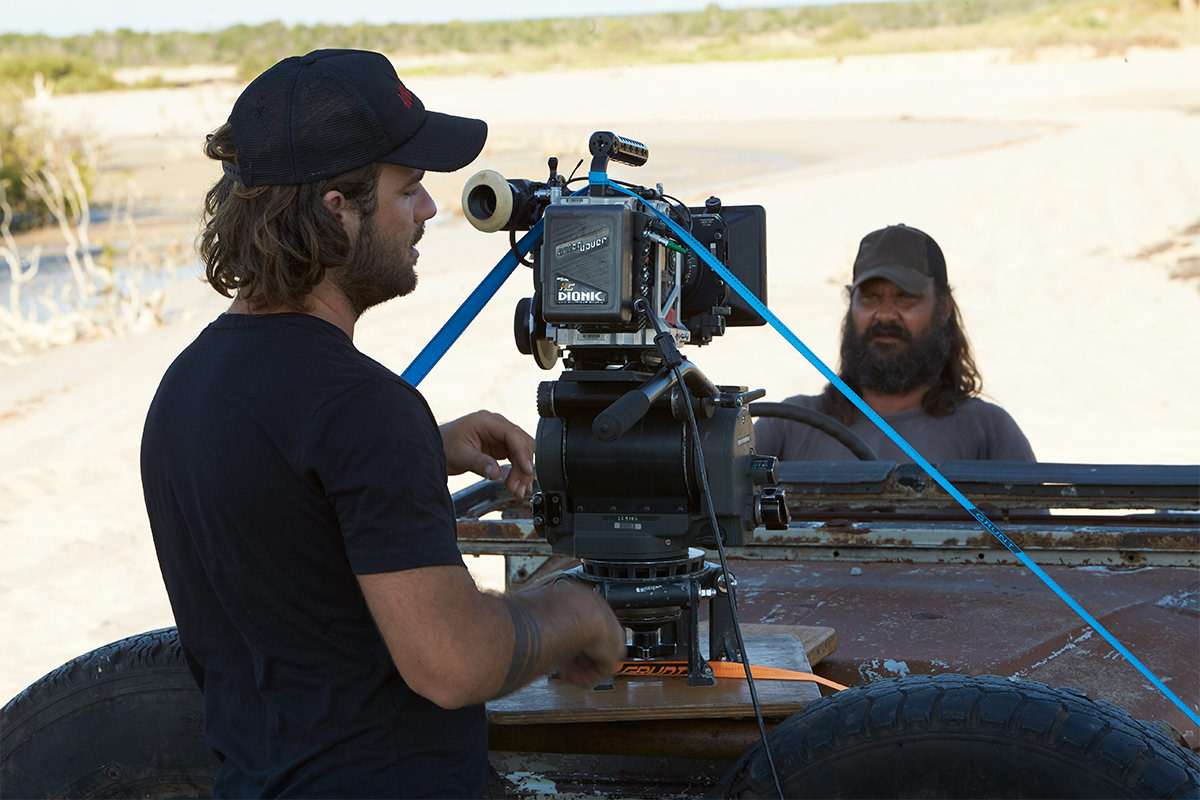 Dylan River filming The Beach with Warwick Thornton
Dylan River filming The Beach with Warwick Thornton
A beautifully-crafted 6 x 30 minute documentary, in The Beach acclaimed filmmaker Warwick Thornton (Sweet Country, Samson and Delilah) became both director and subject, turning the camera on himself during a self-imposed isolation in Western Australia as he tried to transform his life. Holed up in a corrugated iron beach shack, Thornton had no electricity, no alcohol, and no entertainment (bar a guitar and a few chickens). What he does have is a lot of basic ingredients, some old hunting skills, and a passion for cooking – all captured in mesmerising detail by his son and fellow filmmaker Dylan River. Read more about The Beach here
Dylan River: Panavision have been hugely supportive in both mine and Warwick [Thornton]’s careers. His relationship goes back decades and I’ve followed with a great relationship of my own. They are known for great lenses, but it's been a while since they had their own camera system, and so there was a great excitement for me testing and shooting on the DXL and DXL2. The pictures from large format allow you to be wider and closer to a subject, without an unnatural feeling, or distortion. It feels very real, and this is the aesthetic we wanted for The Beach. The DXL2 shares RED's MONSTRO sensor. For The Beach I chose to use the Red MONSTRO because it's slightly smaller and I was able to carry it around by myself easily. For other projects since, I have chosen the DXL2 because of its better integration for production needs, Panavision accessories, and superior colour science over the RED. I shot 90% of The Beach on the PRIMO70 40mm lens. This, I found, gave the closest compression to what I saw through my eye. It was important to keep things simple and natural. I took the whole lens kit from Panavision and a majority of them never made it out of the box.
Watch The Beach on SBS On Demand now.
Cinematographer: Sky Davies, Erika Addis, Anna Howard ACS
Director: Catherine Dwyer
Filmed on a variety of cameras, lenses and formats, including the Black Magic Design Ursa Mini Pro G2 in 4K with an L series Canon 24-70mm lens
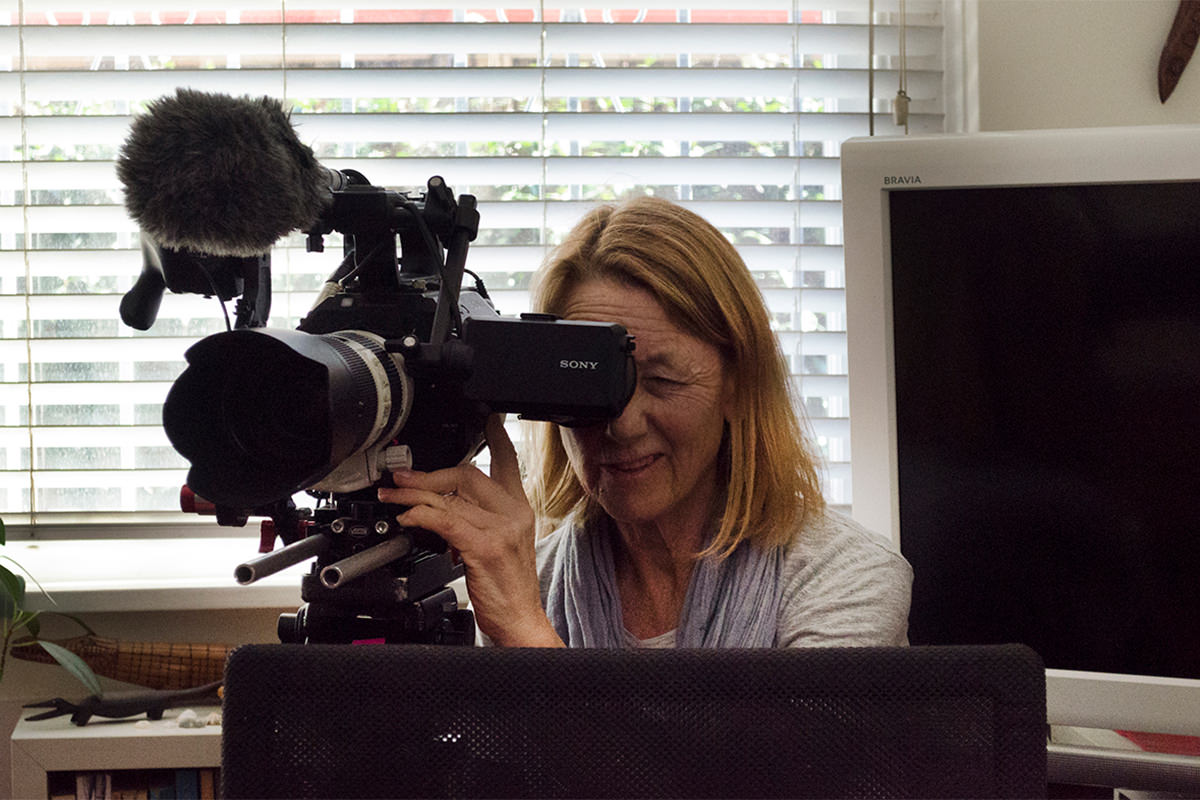 Anna Howard ACS - one of three cinematographers who worked on Brazen Hussies along with Erika Addis and Sky Davies.
Anna Howard ACS - one of three cinematographers who worked on Brazen Hussies along with Erika Addis and Sky Davies.
Written and directed by Catherine Dwyer in her feature documentary debut, Brazen Hussies tells, for the first time, the overlooked stories of the bold women that ignited the second-wave of feminism in Australia and kicked off a feminist revolution during the Women’s Liberation Era. As one of the film’s three cinematographers Erika Addis says, Brazen Hussies “was shot over an extended period of time, both before and subsequent to raising sufficient funds to make and complete the production.” As a result it was shot on a variety of cameras, lenses and formats, but Addis explains her choices below:
Erika Addis: I chose to shoot on the Black Magic Design Ursa Mini Pro G2 in 4K, particularly because of the quality of how the camera renders skin tones. The colour tones of the Black Magic Design Ursa Mini Pro G2 have a clean and natural feel which were right for this film. As we were filming older women, I paid special attention to ensuring they were well lit using soft sources, with as low a level of light as possible to help make the filming environment comfortable for the subjects. I was working at the long end of the L series Canon 24-70mm lens to subtly soften the textures of their skin, shooting at T2.8 around 60mm-70mm.
Knowing that the interviews will form an important body of work in the NFSA collection in the future, I chose 4K as the best format with the longest life available at the time within the budget of the project. It’s vital to have an eye to the future use of all material one shoots, and especially records of significant movements in Australian history, such as Brazen Hussies is.
Brazen Hussies is showing in select screenings around the country. Visit here for more information on where to watch.
Cinematographer: Jack Shepherd
Director: Charlie Ford, Sophie Hardcastle
Filmed on RED Epic Dragon with Zeiss Super Speed prime cine lenses and Black Pro Mist Filters
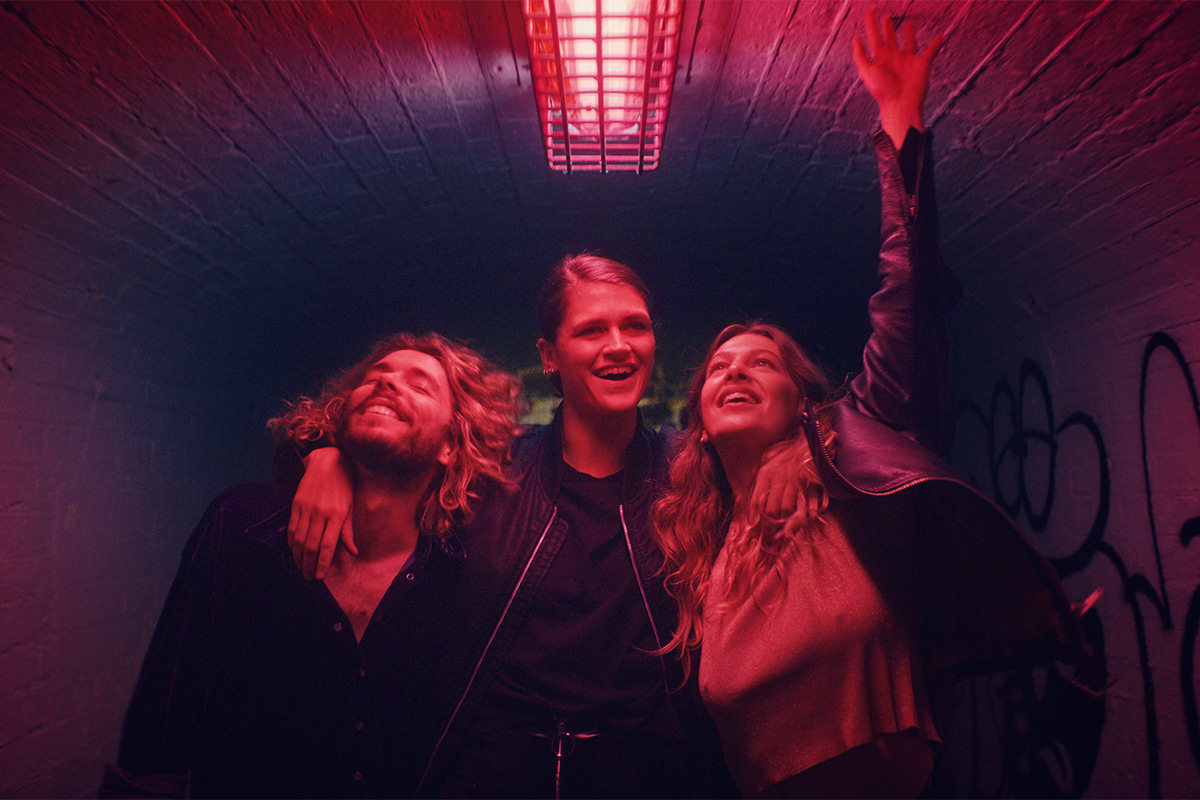 Cloudy River
Cloudy River
Inspired by the real-life experiences of co-writers and co-directors Sophie Hardcastle and Charlie Ford, this 6 x 8 minute web series premiered to sold-out screenings at the Queer Screen’s 27th Mardi Gras Film Festival in 2020 and follows pan-sexual artist Emma (aka Cloudy) and musician River whose relationship is put to the test when they move in together.
Jack Shepherd: For Cloudy River we shot the entire series on a Red Epic Dragon for many reasons. We had a 4k delivery requirement so shooting in 6k allowed more room in post for effects, reframing, stabilization etc. For lenses I went with a set of Zeiss Super Speed prime cine lenses. From experience I loved how the lenses themselves have a beautiful creamy look especially when I add Black Pro Mist Filters. I shot most of the series with a 1/2 BPM filter in but dropped to 1/4 for wide exteriors. The Super Speeds are extremely compact and I knew this was crucial as there was going to be some very intimate scenes in small sets where I wanted the camera to be a small rig and less intimidating for the actors.
Watch Cloudy River on SBS On Demand now.
Cinematographer: Meg White
Director: Julie Kalceff
Filmed on 2 x ARRI ALEXA Classic, Sony Fs7 and GH5 (underwater) with Cooke S4s, 15-40mm and 45-120mm Angenieux Optimo Zooms
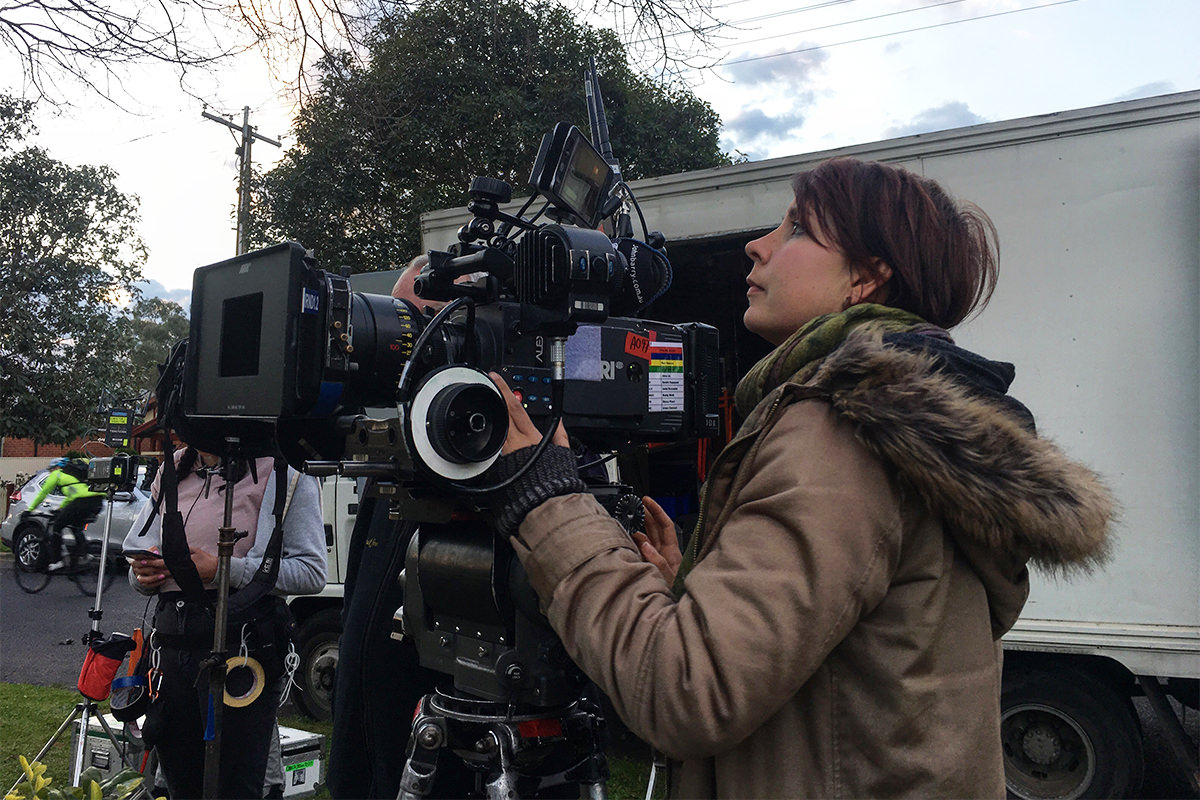 Meg White on the set of First Day
Meg White on the set of First Day
In this ground-breaking series for ABC ME, writer/director Julie Kalceff (Starting from Now) expanded on the short film of the same name to follow the story of Hannah Bradford (Evie Macdonald), a 12-year-old transgender girl navigating the challenges that come with starting high school, as well as the courage to live as your authentic self. First Day went on to win a prestigious Rose d’Or Award in the Children and Youth category, which celebrates screen excellence from around the world.
Meg White: First Day is a highly subjective series that follows the journey of transgender student Hannah Bradford as she begins high school. Taking reference from the French film Tom Boy, I sought to combine naturalism, graphic simplicity and a playful aesthetic to produce a distilled quality that never overtook the experience of its main character. It was crucial to have a grounded empathetic feel to the show where our look needed to avoid that of ‘elevated’ kids TV or highly stylised queer content that can present characters as larger than life. Authenticity was key in never visually downplaying Hannah’s challenges but never making them inaccessible for our younger audience, something always kept in mind particularly when lighting more sombre scenes. For budget and aesthetic reasons we shot ALEXA classic and Cooke S4s as I wanted the rounded warmth of the Cookes and the reliable rendition of skin tones that the ALEXA provides. Overs and clean singles became part of Hannah’s character arc. Whenever she is in a moment of confrontation or empowerment, she would be covered by clean singles which were employed in distinct moments in the series.
Watch First Day on ABC iview now.
Cinematographer: Bonnie Elliott ACS
Director: John Sheedy
Filmed on ARRI ALEXA Mini with Panavision Close Focus Primos
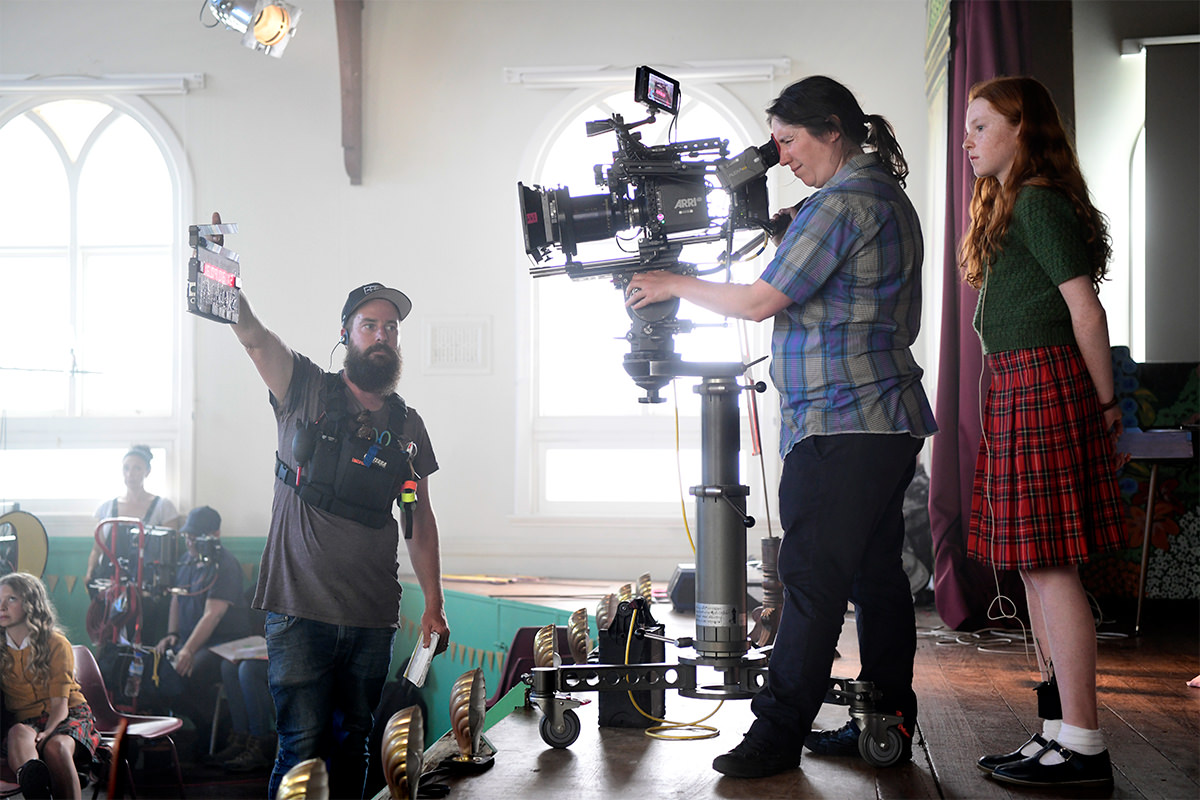 Bonnie Elliott ACS on the set of H is for Happiness
Bonnie Elliott ACS on the set of H is for Happiness
Based on the award-winning book My Life as an Alphabet, this family film made its world premiere at Berlin International Film Festival in 2020 and marks the directorial debut of acclaimed theatre director John Sheedy. It follows eternally optimistic Candice Phee (Daisy Axon), who with the help of new friend Douglas Benson (Wesley Patton), devises a scheme to help mend her broken family.
Bonnie Elliott ACS: H is for Happiness was shot on the ARRI Mini camera, for sensor performance and versatility of configuration. In many ways I feel the biggest decision a cinematographer makes with their kit these days is lens selection. H is for Happiness is a film that sits in a slightly magical, storybook world, and director John Sheedy and I were inspired by the wide angle lensing of films like Amelie and Sweetie. After extensive testing we chose the Close Focus Primos from Panavision, as we loved how close we could bring an actor or object to these lenses without the need for diopters. Indeed the very first shot of the film is a big close up on a strangely roving eyeball, that quickly pulls back to reveal the wonderful Miriam Margoyles as Miss Bamford. Another time the camera rushes in to the mouth of a screaming teenager at the arrival of a terrifying relief teacher, close enough to see her chewing gum! We had a lot of visual fun with those lenses, which is an important part of making a film for kids and families to enjoy.
Stream H is for Happiness on Binge, Foxtel Now and Amazon Prime now.
Cinematographer: Maya Newell
Director: Maya Newell
Filmed on Sony PXW-FS5 with a Canon 24–70mm f/2.8 zoom, 1.2 Canon 50mm prime and a Canon 18–35mm zoom lens (second camera Canon 5D Mark III)
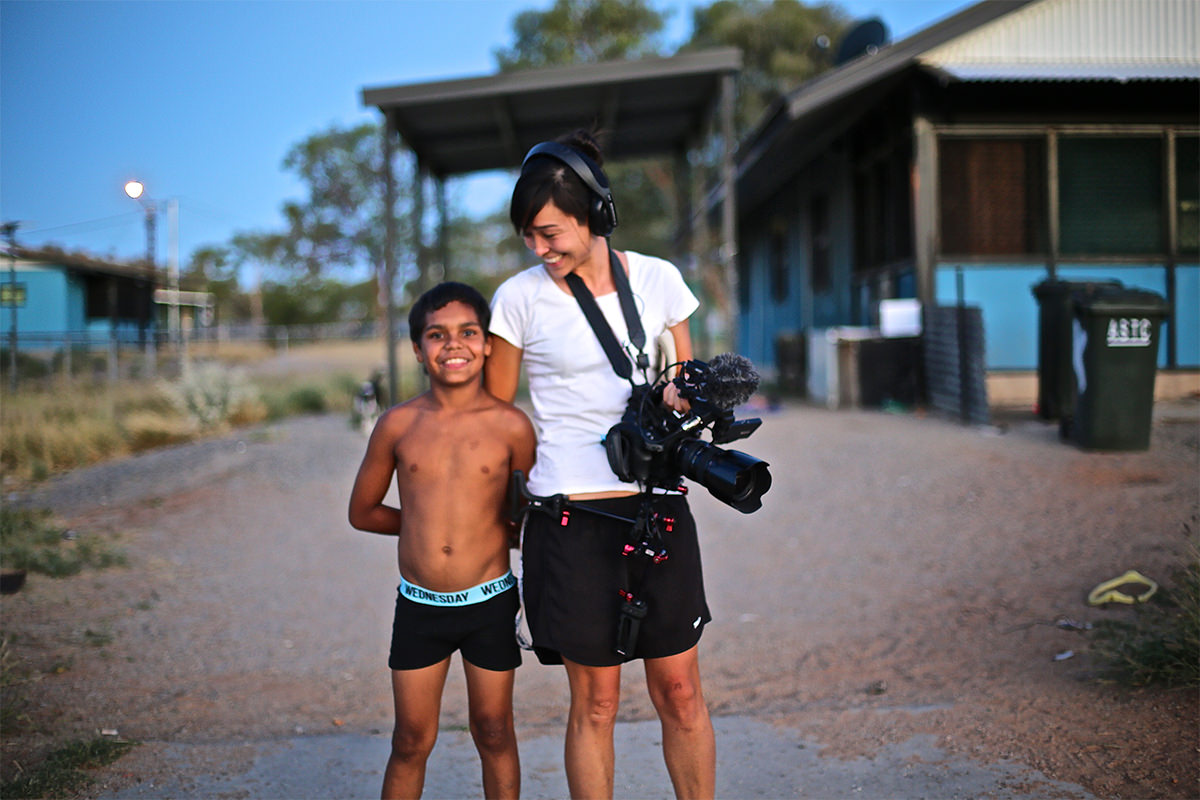 Dujuan and Maya Newell behind the scenes of In My Blood It Runs
Dujuan and Maya Newell behind the scenes of In My Blood It Runs
Shot in Mparntwe (Alice Springs), Sandy Bore Homeland and Borroloola Community in Northern Territory over three and a half years, this observational documentary follows 10-year-old Dujuan who lives with his family on the outskirts of Alice Springs. Dujuan has a strong Arrernte Country education: he’s a child-healer, a good hunter and speaks three languages. But when it comes to the western curriculum, he “is 'failing' in school and facing increasing scrutiny from welfare and the police”. Made in collaboration with the Arrernte and Garrwa families in the film, In My Blood It Runs follows Dujuan’s journey as he grapples with these pressures and “somewhere in-between finds space to dream, imagine and hope for his future self”.
Maya Newell: When it came to In My Blood It Runs, we wanted to build on the strength of Gayby Baby, and what I’d learnt was that there is a magic and trust with those onscreen, especially with children, when they feel empowered and are not overpowered by a large crew. We wanted to prioritise and reach for that intimate kind of drama so decided that I would shoot most of the film by myself. In 2016, there were few cameras on offer that I could 1) afford; 2) that were light enough that I could run around for hours without my arm falling off and; 3) had on board sync sound.
So not willing to take on another non-sync sound challenge, I opted for the lightweight Sony PXW-FS5, which combined with Canon lenses could offer the quiet cinematic quality we were going for. I also love that on this camera there is a single push slow-motion button whereas, on most cameras, you have to go into a menu and find the frame rate you want, by which time, if you’re filming a small child with a firework, you’ve completely missed the moment. We framed for 2.39:1 widescreen, wanting the desert landscapes to draw audiences in, and to create a wraparound experience of Dujuan’s world.
Running around the desert in and around Mparntwe/Alice Springs after kids, my biggest concern was being agile. I chose a Canon 24–70mm f/2.8 zoom as my workhorse lens, but also carried a 1.2 Canon 50mm prime and an 18–35mm zoom. Mostly I’d film in mids and close-ups within a foot of those on camera, in part because I am intuitively drawn to intimacy as a pathway to empathy, but this was also a practical choice as it was necessary without a sound recordist (most of the time) to capture quality sound through the onboard shotgun mic. While radio mics were affixed to Dujuan he was often running and playing and tumbling so the sound quality was sketchy at best.
Significantly, Dujuan was a second camera operator, and his interviews of family members are shot on the Canon 5D Mark III. We established this was his camera to bring out and use whenever he wanted and it also brought equilibrium to our relationship as he could interview me before I interviewed him (a requirement from Dujuan) and also use the camera to learn about filmmaking himself.
Stream In My Blood it Runs on Beamafilm now, or rent/buy on iTunes, Fetch or YouTube.
Cinematographer: Bonnie Elliott ACS
Director: Emma Freeman, Jocelyn Moorhouse
Filmed on 2 x ARRI ALEXA Minis with Zeiss Super Speeds and Angeniuex short zooms
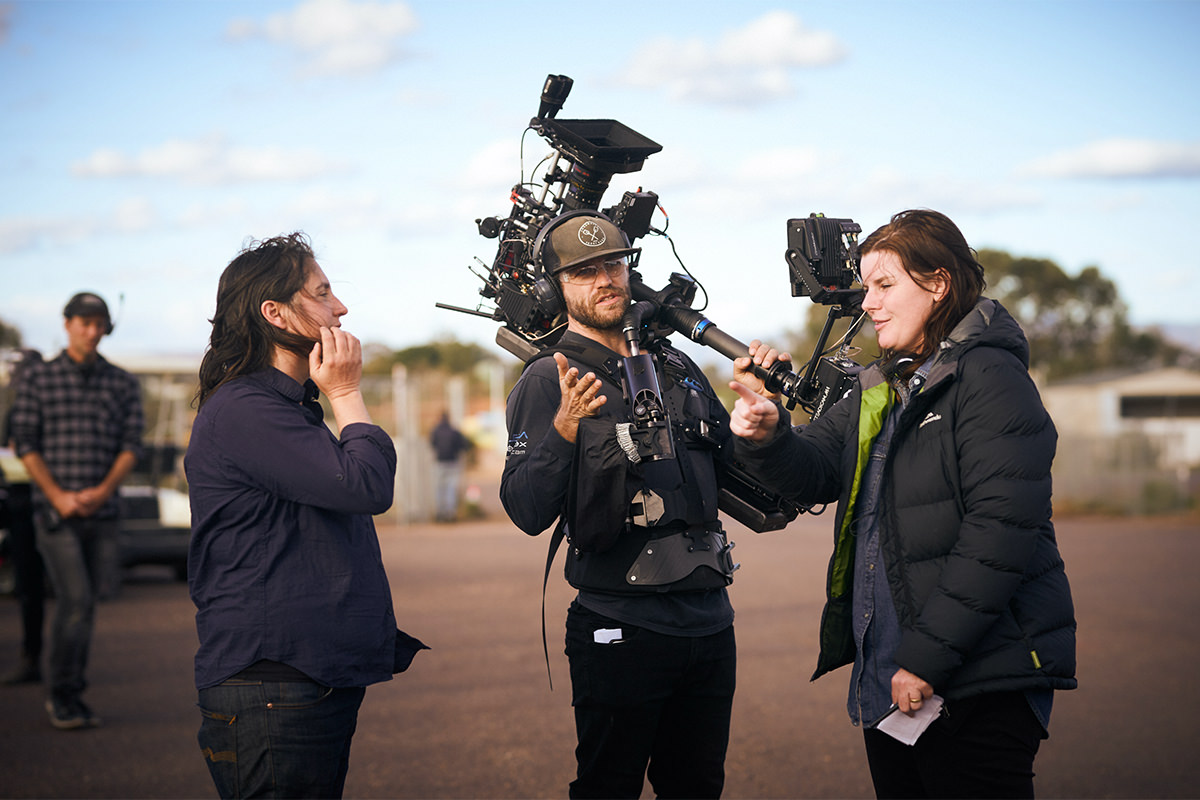 Bonnie Elliott ACS, Tim Walsh & Set up Director Emma Freeman discuss a shot on Statekess (Photo credit: Ben King)
Bonnie Elliott ACS, Tim Walsh & Set up Director Emma Freeman discuss a shot on Statekess (Photo credit: Ben King)
After premiering at the Berlin International Film Festival in early 2020, this six-part series co-created by Elise McCredie, Cate Blanchett and Tony Ayres for the ABC follows four people caught up in Australia’s immigration system and stars the likes of Blanchett, Yvonne Strahovski and Fayssal Bazzi (read Fayssal’s Advice from Isolation article here and an interview with Stateless showrunner/co-creator Elise McCredie here). It dominated the AACTA Awards television categories and won 13 prizes, including Best Cinematography for Bonnie Elliott ACS who explains her choices below:
Bonnie Elliott ACS: My favourite lenses are Zeiss Super Speeds, and they seemed just right for Stateless as they have enough character to take the image away from something clean and digital, and embue it with humanity and warmth, without ever becoming romantic. In recent times I have embraced using zooms more on episodic drama, working with the Angeniuex short zooms which give you speed and flexibility, and above all momentum! Emma Freeman is a performance oriented director, she will often want to shoot close ups first, and I thought she would be happy not to wait for a lens change, or re-balance of the Steadicam rig, to stay in the moment with the actors. I mostly used the zooms for day exterior scenes, as I tended to favour the Super Speeds for magic hour, night work and interiors, as I love the way they flare, and our Detention centre set had so many wonderful sodium vapour lights that did just that! The ever supportive Panavision Australia supplied us with two Alexa Minis, a truly versatile and reliable camera, and one I know so well that it frees me up to concentrate on storytelling in a really liberating way.
Watch Stateless on ABC iview now.
Cinematographer: Charlie Sarroff
Director: Natalie Erika James
Filmed on ARRI ALEXA SXT and ARRI ALEXA Mini with Cooke S4 lenses
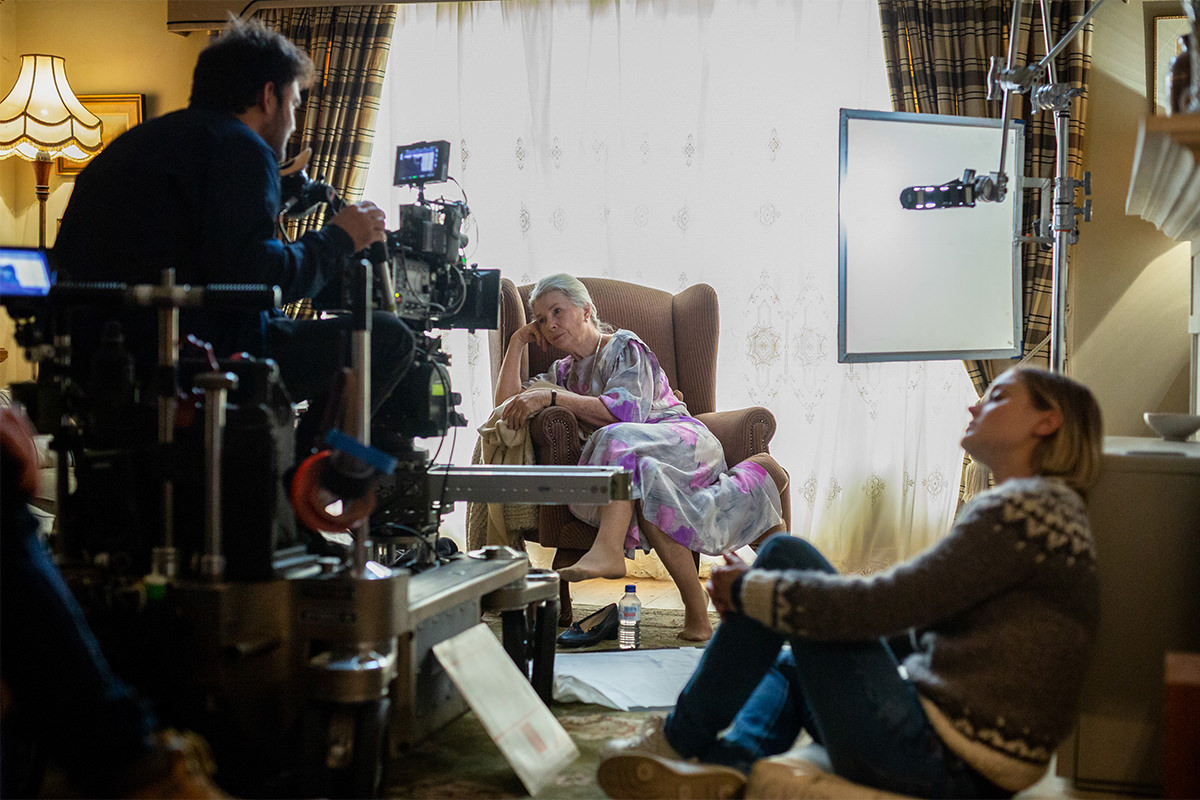
Relic premiered at Sundance Film Festival in 2020 and it stars Emily Mortimer and Bella Heathcote as a mother and daughter who travel back to their remote family home after the disappearance of widowed matriarch Edna (played by Robyn Nevin). When Edna returns, her daughter and granddaughter start to wonder if her Alzheimer’s symptoms are actually something else entirely. Relic also marks the feature directorial debut of Natalie Erika James, which was based on her short film Creswick (that DOP Charlie Sarroff also shot). Find out more about the making of the film through the podcast episode with James here
Charlie Sarroff: Relic explores the devastating effects dementia has on not only those suffering from it but their family as a whole. On Relic, we opted to use the ARRI ALEXA cameras for their filmic qualities, efficient workflow, dynamic range and low light capabilities. We predominately used the ALEXA SXT as A Camera and then switched to the Mini for gimbal shots and handheld work in tight spaces.
We used Cooke S4 lenses because we liked their contrast and how they capture skin tones, the focus roll-off is flattering and they have the consistency and reliability of modern lenses across all focal lengths which was important as we shot mostly at wide apertures, but the lenses still have some pleasing characteristics alike to older lenses. We also liked how the Cooke S4's handled flares and rendered practical light sources. We predominantly used wider focal lengths, 18mm, 25mm, 32mm and then used longer focal lengths for pivotal moments in the film.
We shot Opengate ARRI Raw which allowed us to use the maximum sensor size with the most information which was important to us considering so much of the film was shot in darker spaces.
Watch Relic on Stan now.
NOT FROM THE CAMERA DEPT?
Here are two key terms that will come up:
- Lens: There is the camera itself and then a lens – also referred to as ‘glass’. They can be spherical or anamorphic and can be zoom or a ‘prime lens’, which has a fixed focal length (meaning you can’t zoom in or out). There are pros and cons to each. They are purchased separately – in fact they can be a completely different brand to the camera. Additionally filters – in conjunction with lenses – can be used to alter the exposure, colour and more. Productions will also typically hire cameras and lens kits.
- mm: The focal length of the lens is usually represented in millimetres or ‘mm’. The smaller the number, the shorter the focal length and the wider the field of view. The bigger the number, the longer the focal length and the narrower the field of view.

What to read next
Cinematographers from Australian films, television, documentary and online series share the camera and lens choices that brought the stories to life.
29 Jan 2020
Caris Bizzaca